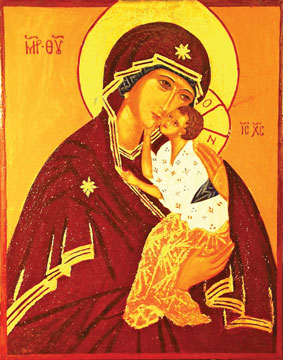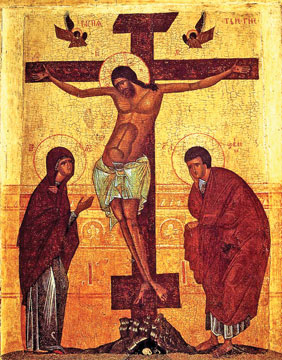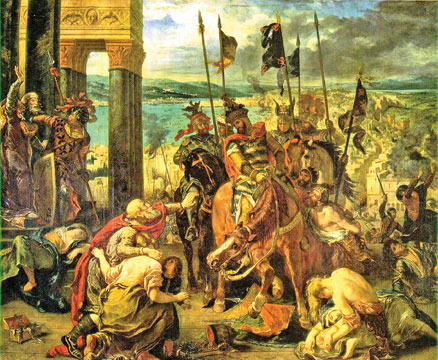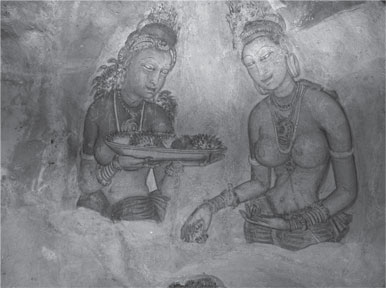Of fifth century paintings
By Shireen SENADHIRA
Looking back on styles of art, the 5th Century is significant in that
there evolved two distinct styles of art pertaining to Sri Lanka (then
Ceylon) and Istanbul, Turkey.
 A bevy of alluring damsels having high foreheads shaping their faces
with enticing doe eyes, a rose coloured blush on their cheeks and lips
like lotus buds look down from a highly polished walled called a mirror
wall. A bevy of alluring damsels having high foreheads shaping their faces
with enticing doe eyes, a rose coloured blush on their cheeks and lips
like lotus buds look down from a highly polished walled called a mirror
wall.
These maidens wear blouses of gossamer veil, the texture of which are
silken cobwebs woven in the wind, seven layers of this diaphanous
material is like evening dew on grass and similar to running water.
These lovely maidens have dressed their hair piled up high to show
their oval faces of lustrous complexions. They have heavy breasts and
their eyes express moods from vivacity to serenity. They wear elaborate
jewels on their hair, ears and arms. Large hooped earrings dangle from
their ears and they wear armlets as well as bangles. Numerous necklaces,
some having large pendants too are worn. They stand in a row carrying
flowers, trays of flowers bestowing the most enigmatic of smiles.
Frescoes
They stand looking in one direction as if they are going to a nearby
temple in Pinduragala. They are, of course, the renowned frescoes of a
rock fortress, called Sigiriya, Lion mountain, found in the heart of Sri
Lanka and existing since the 5th century. These maidens have been in
their aerie heights of half way up a 180 meter rock face, through
sixteen centuries. They have been painted on a mirror wall and now
number only 21 out of a veritable 500.
At that time a rock face of about 150 meters in length would have
formed one of the largest picture galleries of the world. Imagine
looking at such a picture gallery from below. An array of colours on
bewitching maidens would have certainly mesmerized the onlooker.
The mirror wall was thus named because of its highly glazed plaster
which is believed to have been made up of a mixture of lime, plaster and
egg white. This wall still reflects the face of the onlooker.
Sigiriya is an extraordinary site of a lofty rock of red gneiss
rising up like a citadel, some 180m from the neighbouring plateau that
has been inhabited since the 3rd century BC. This has been attested by
the graffiti which proliferates in the grottoes and shelters of the
boulders.
The fame of Sigiriya is mostly due to one factor, that is, during the
5th century, a flamboyant sovereign, King Kasyapa I, established his
capital there. A king who had an immense aesthetic sense. Sigiriya is
believed to be the symbolic reconstruction of Alakamanda, the mythical
abode of the Hindu God Kuvera. It was built to resemble a crouching
lion. Only a giant brick head and paws of the lion constructed at its
northern end still remain to give measure to the original lion
structure. It is through the lion’s throat, a stone staircase was
constructed to ascend to the top.
Sigiriya is an architectural marvel and the best known example of
ancient Sri Lanka’s civil engineering. Design architects have cleverly
patterned a complex system of parks, ponds and pavilions with an
excellent grasp of eco-design, taking into account the elements of
nature. It is also with pride and amazement one can see the placements
of different gardens by the then landscapists in three sets, the water
gardens, the boulder gardens and the terraced gardens.
There were gardens on top of the rock as well as below, on the
ground. An intricate irrigation system was discovered that watered the
gardens , kept the ponds flushed at all levels and the fountains playing
too.
The island Sri Lanka is proud of its long civilization which is rich
and colourful. It occupied a pivotal position in the ancient Silk Road
and functioned as a cultural highway between the East and the West. This
gave the island a cosmopolitan character since pre-Christian times. The
history of Sri Lankan painting and sculpture can be traced as far back
as to the 2nd and 3rd century BC. The ancient chronicles have
descriptions of paintings in the relic chambers of Buddhist stupas and
monastic residences. Fragmentary remains of ancient wall paintings have
been recorded from various archeological sites.
Sculpture
 The stylistic features of ancient sculptures shed light on the
formation of Sri Lankan classical style of sculpture and painting. The
work of the mid historical period shows the persistence and continuity
of this style throughout the period. Anuradhapura, an ancient city had
its buildings, paintings and sculpture in this classical style. Early
Sri Lankan paintings are found in the ruins of Mathyangana and Mihintale
stupas as well as in Gonagala and Karambaglala. The stylistic features of ancient sculptures shed light on the
formation of Sri Lankan classical style of sculpture and painting. The
work of the mid historical period shows the persistence and continuity
of this style throughout the period. Anuradhapura, an ancient city had
its buildings, paintings and sculpture in this classical style. Early
Sri Lankan paintings are found in the ruins of Mathyangana and Mihintale
stupas as well as in Gonagala and Karambaglala.
Even though the Sigiriya frescoes can be located within the broad
stylistic aspects of Anuradhapura period paintings it has its unique
features in terms of lines and its application. The multiple sketchy
lines of the Sigiriya frescoes impart an ambience of sketchiness and
swiftness that established the sense of full volume in the shapes and
forms of the figures by giving rise to a subtle spatial ambiguity at the
edges of the painted forms. This brings about the sense of volume on a
flat surface and is further confirmed by the way the paint has been
applied.
The paint has been applied in sweeping strokes, imparting slightly
more pressure on one side of a flat brush which has thus created a
deeper colour tone along the edges of a shape. This has also resulted in
leaving a high tone area on the shapes and forms of figures. This was a
commonly used feature in the Anuradhapura style of paintings and can be
seen in the frescoes of Mahiyangana and other temples. The main
characteristic of the lines of Anuradhapura painting style, including
that of later Polonnaruwa is that it is a sure and precise linear mark
registered on the surface and also the last line of the artists.
In contrast, the sketchy and exploratory nature and their application
in the Sigiriya lines make them distinctly different among the frescoes
of the Anuradhapura period. These paintings of the Sigiriya frescoes
represent the earliest surviving examples of a Sri Lankan school of
classical realism, already fully evolved by the 5th century.
Reaction
Imagine how startled the viewer would have been when he espied these
paintings on a ledge high up on the rock through a telescope from the
forest ground below. That is exactly how a Buddhist scholar, T W Rhys
Davids reacted when he saw this bevy of wall flowers. Though Sigiriya
remained inaccessible after King Kasyapa’s time for centuries it was not
forgotten, there was an especial flow of curious western visitors in
early 19th century.
The mystery as to who painted the beautiful ladies went on and also
how they were protected beneath an overhanging rock. Murray, an
Englishman took on the arduous task of climbing the precarious rock in
late 19th century and was successful of making drawings of these
mysterious frescoes, also called apsaras. From then on, there was no
stopping the archeologists and historians who cleared the jungle,
excavated, dated and restored the intricate site much as they possibly
could. Even at present, the work is going on. Now it is easily visited,
seen, the summit is accessible and the marvelous sites of the palaces
and gardens can be viewed with pleasure.
Exquisitely painted in brilliant colours the frescoes resemble the
Ajanta paintings of India. Having no religious significance they are
considered to be representations of the beauties of the King Kasyapa’s
court. An inscription on the nearby mural wall alludes to ‘Five hundred
golden ones’ but sadly at the time of rediscovery there were only twenty
one of the frescoe paintings only. The dark ladies were referred to as
cloud maidens and the light skinned ones as the lightning princesses.
These figures look very sensuous and have aroused inflicting emotions in
visitors down the years. A male admirer had scratched his verse as:
‘the ladies who wear golden chains on their breasts beckon me. Now I
have seen these resplendent ladies, heaven has lost its appeal for me.’
A contemporary female, however, less enamoured with the frescoes
records a different passionate emotion in:
Maiden
‘A deer eyed maiden of the mountain side arouses anger in my mind. In
her hand she holds a string of pearls and in her eye she assumes rivalry
with me.’
Greatly inspired by the Sigiriya beauties many viewers had inscribed
verses to them on the walls below the mirror wall and walls of the caves
below. These are known as Sigiriya Graffiti and are dated from the 6th
century to the 14th. Nearly 700 of these have been deciphered and
recorded. Such revealing comments of the paintings provide an insight to
the cultivated sensibilities of the time and its appreciation of art and
beauty.
At this same time, half way across the globe from Sri Lanka, in the
Byzantine Empire that arose from the previous Roman times, mosaic art
and icon art developed into a great style of Byzantine art. The finest
work, the most elegant and accomplished technically, was naturally
associated with the Byzantine capital, Constantinople, which was the hub
of the civilized world. Byzantine art is the term used to describe the
artistic products of this empire from the 5th century onwards. Byzantine
art also flourished in the states which were contemporary with the
Byzantine Empire and shared a common culture with it, without actually
being part of it, such as Bulgaria, Serbia, Russia, Venice and the
Kingdom of Sicily. The tradition of Byzantine art can be seen in Greece,
Russia and other Eastern Orthodox countries in the present day.
 |
|
A byzantine painting |
The Byzantine area was the Eastern Roman empire. It was Emperor
Constantine I who shifted his capital to Byzantium on the Bosphorous in
the 4th century. Byzantium became Constantinople, ‘City of Constantine,’
and much later during the Ottoman Empire became the now Istanbul. This
empire remained the most powerful economic, cultural and military force
in Europe despite set-backs and territorial losses from various wars.
The Byzantine Empire existed from the 4th century till 1453 when it was
overpowered by the Ottoman Empire.
Byzantine art is the artistic products of the Byzantine Empire. Just
as the Byzantine Empire represented the political continuation of the
Roman Empire, Byzantine art developed from the art of the Roman Empire.
It must be kept in mind that Roman art was greatly influenced by ancient
Greek art. Thus Byzantine art never lost its identity with this
classical heritage.
Therefore, Byzantine art grew from the art of Ancient Greece but was
distinguished from it in a number of ways. The most prominent of these
was that the Christian ethic replaced that of the humanist ethic of
Ancient Greek art. If the purpose of classical art was the glorification
of man, the purpose of Byzantine art was the glorification of God and
his Son, Jesus. This had its consequences. Classical artistic tradition
having nude figures was banished. Old pagan idols and motifs were taken
over lock, stock and barrel. It is said that the disadvantage of this
type of art was a decline in the importance of naturalistic
representation of art and it also lost interest in realistic
portraiture. Christian art became dominant with the figure of God the
Father, Jesus Christ, the Virgin Mary, the saints and the martyrs. It
also replaced the classical preoccupation with the human body.
Icon
The most important form of Byzantine art, which is still dominant,
was the Icon. An icon is a religious work of art, most commonly, a
painting, more broadly used in a wide number of contexts for an image,
picture or representation. In modern culture an icon is a symbol
representing a face or picture. It is generally an image or depiction
that represents something else of greater significance through literal
and figurative meaning.
In the same vein, mosaic is the art that creates images with an
assemblage of small pieces of coloured glass, stone, shells and ivory.
These pieces are roughly cubic in shape and pasted to create a pattern
or picture. In time, mosaic art preceded icon art. It must be mentioned
that the famous Russian icon painting began by entirely adopting and
imitating Byzantine art. So did the art of other orthodox nations. These
have remained conservative although the painting style has developed
distinct characters. For example, the depiction of the nativity of
Christ, vary very little in content from the 6th century to the present.
New techniques were developed by the Byzantine artists to reach new
heights. Byzantine gold and silversmith work, enamel work, jewelry,
textiles and carpet weaving preserved their quality from then till now.
In mosaics and icon painting they developed original art forms of their
own. In architecture they achieved masterpieces such as Hagia Sophia
church, a magnificent structure in the ancient world.
Influence
In truth, Byzantine art is not so easily encapsulated. Its
distribution, artistic influence, and sources of inspiration extend well
beyond the territorial boundaries of the Empire. Its roots can be traced
in the pagan arts of Greco-Roman antiquity, and its legacy is clearly
visible in the arts of the Italian and Northern Renaissance, medieval
and modern Russia, and even of places far more remote in time and place,
such as we see in the Byzantine revival architecture of London's
Westminster Cathedral.
The Byzantine artists learned anew the classical conventions for
depicting the clothed figure in which the drapery clings to the body of
the figure, thus revealing the forms beneath. This was called the
damp-old style. They also included modeling in light and shade which not
only produced the illusion of three dimension but also animation to the
painted surface.
As religious images did not allow the human figures as bodily
presence, the artists cleverly used abstraction to overcome this
problem. They did it by rendering the darks, halftones and lights as
clearly differentiated patterns thus preserving the visual interest of
the figure while avoiding any actual modeling and with it the semblance
of corporeality. In this way the conventions for representing the human
figure were established which remained for the later centuries of
Byzantine art.
Mosaics
Great works of mosaics are found in major scale in the wall paintings
of Coptic Egypt and the Balkans, the sculptures that decorate the
tympana and facades of many churches in Armenia and Georgia. Actually,
the wall space that was covered by mosaics and frescoes in the East
Christian world has never been exceeded by, even Renaissance Italy. Most
of these have perished with the ravage of time but still the surviving
ones display high quality. These bring out the glory that once
characterized Church Art.
 Some such paintings can be seen in Museums of Istanbul, the Hagia
Sophia and the Palermo Cathedral in Sicily. Special mention must be made
of the Rila Monastery in the Rila Mountains of Bulgaria. The monastery
consists of many large buildings of 10th century intricate architecture
in Byzantine style. The church of the Holy Virgin is the central piece
and has three identical domes. Some such paintings can be seen in Museums of Istanbul, the Hagia
Sophia and the Palermo Cathedral in Sicily. Special mention must be made
of the Rila Monastery in the Rila Mountains of Bulgaria. The monastery
consists of many large buildings of 10th century intricate architecture
in Byzantine style. The church of the Holy Virgin is the central piece
and has three identical domes.
Marble mosaics adorn the floor. As domes and altar areas of large
churches tend to be in semi darkness, these domes were built to enable
light to pierce through the drums of the domes. There is also light from
individual windows that are placed at a lower level than the domes. The
special effect that that the light coming in this way cause an aura in
spotlighting the icons on the wall, that, it is with almost reverence
that the viewers gaze and admire the paintings. Paintings cover every
square inch of wall and ceiling space of the altar areas. In addition,
the most fascinating frescoes are on the outside walls of the church.
The brilliant colours and the scenes they depict in such a mass of
paintings could get anyone’s head in a whirl. The individual stroke
marks of many paintings can be discerned in the frescoes in the
principal church but only one painter, Zograph, has signed and dated
his.
It can be seen that there was Byzantine influence all over Europe and
the world. Byzantine art that began in the 5th century has spurted the
styles of art for many centuries thereafter and is still sought out and
admired.
Castle
After seeing much Byzantine art work, it was almost dusk in Istanbul,
when standing on a balcony overlooking the sea of Marmara, I admired a
lit up castle like building when I saw a cloud formation descending. I
gazed at it and what did I see? It was a sultan on a majestic flying
horse and it flew over the buildings. Next, it turned and headed out to
the sea towards a russet sailed galleon.
Then as it touched the highest mast, it rose in the air and became
hazy. Craning my neck outwards and looking intently I saw a flock of
geese flying away. Did Sinbad see such for his stories? Was this an
effect of much Byzantine art or is this what an evening in mysterious
Istanbul offers?
Well, all in all, an average painting, icon or mosaic can be elevated
to an exquisite stand out image when it strikes a resonance with the
viewer and engages the person on an emotional level. There is no doubt
that the images like the Sigiriya frescoes and Byzantine paintings have
the power to move and captivate anyone.
High evocative images capture the mood, ambience and location so
tangibly that the images almost lift themselves up from their flat
surfaces to acquire a three-dimensional quality. It is this quality that
accomplished artists harness so excellently.
I wonder, in the 5th century and after, these skilled artists while
at work, ever thought their work would evoke such admiration even many,
many centuries later? Hats off to them, they certainly have left their
mark for posterity.
|

